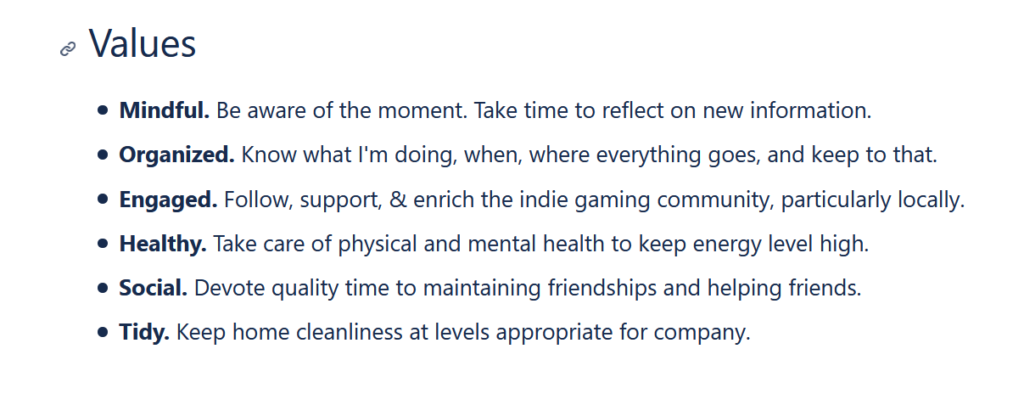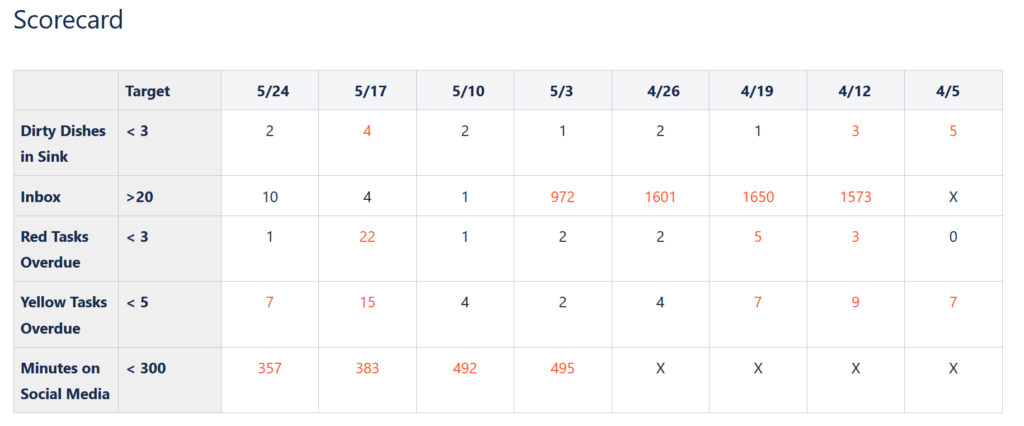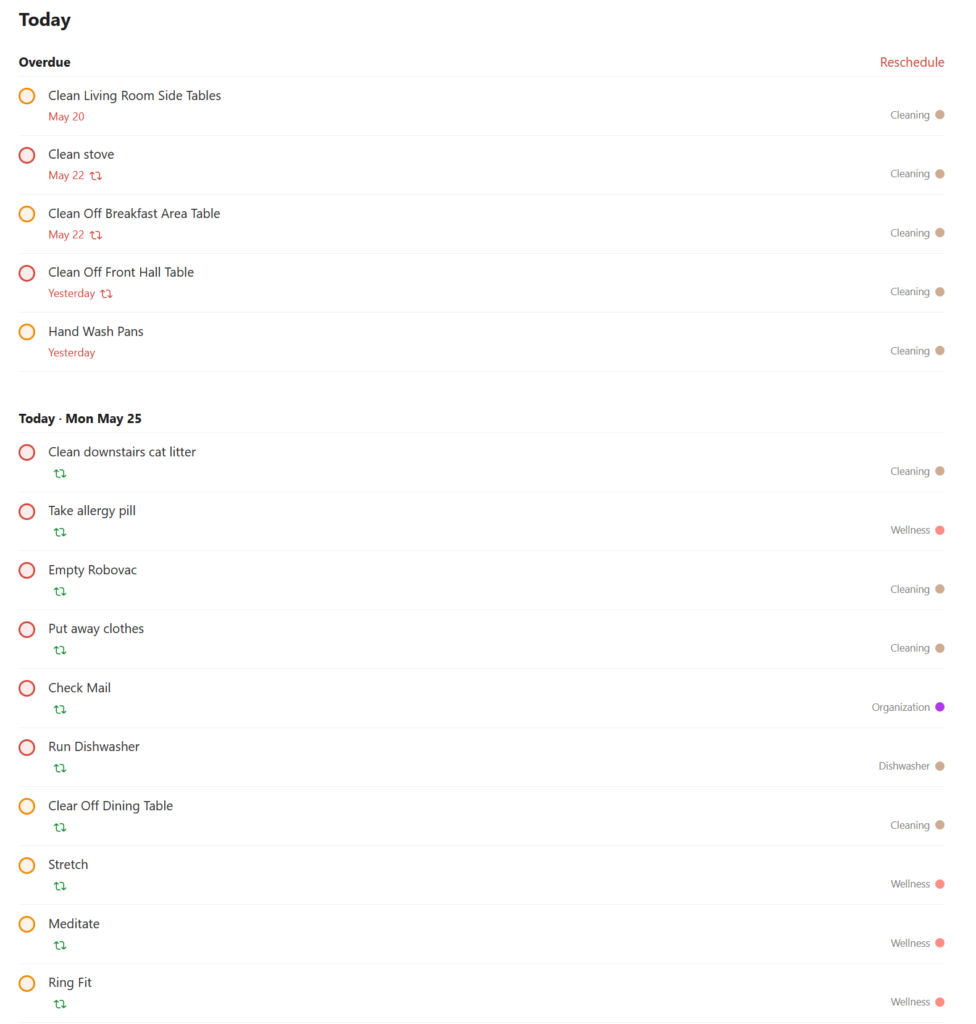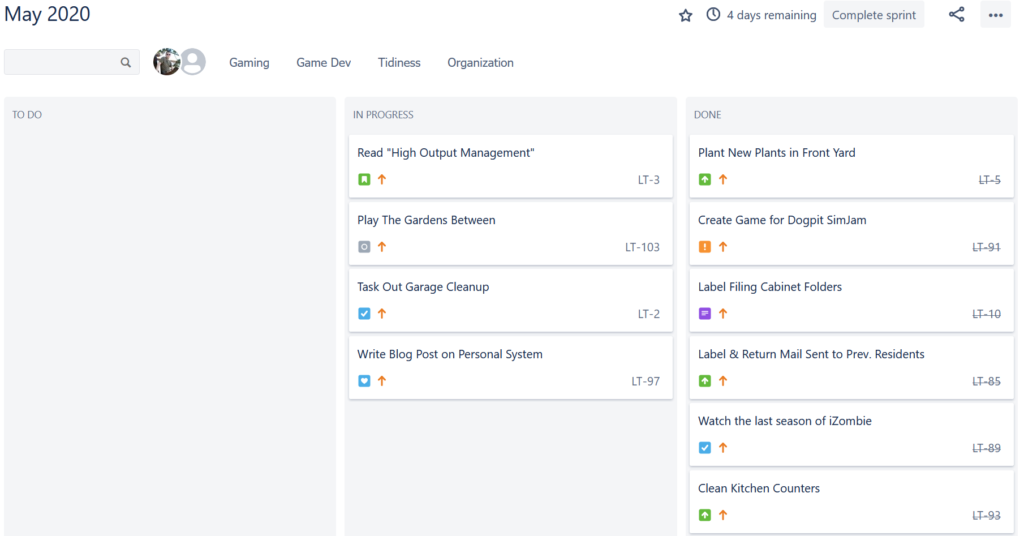I want to share a little bit how I’ve been ordering my life over the past few weeks. I’m someone with an aversion to chaos or uncertainty and a need for order and control, and so generally speaking I haven’t minded being home the past few months. I appreciate stability, and my home is the most stable place I can be. That being said, there’s nothing stable about life right now. Being at home all the time makes things feel like they’re piling up endlessly, and the feeling of time standing still and not seeming to pass is deeply unsettling.
Once the novelty of video meetings and ordering things curbside wore off, I realized depression was setting in and I needed to make some changes. The house was a mess, I was exhausted all the time, and I found myself staring at my phone or social media and letting the minutes slip by. So in April I started focusing on getting my life more organized and building some routines. I know this amount of structure definitely isn’t for everyone, and in fact my level of organization can be stressful for others. That’s okay, we all have different styles. This is mine. For me, this helps.
I already used Todoist to track day-to-day household stuff, but those are just the little tasks that keep things afloat. I needed to build on that and start pushing back against this weird fugue state. I’ve tried in the past doing a system of personal weekly check-ins just like the ones I do at my day job, but it never took before. At work I have a meeting every Tuesday to go over my metrics and identify any issues, an idea originally pulled from something called the Entrepreneurial Operating System. The one at work is in Confluence, and so my home one needed to be, too. The first time I tried to translate this process to my personal life I used a Google Doc, but it just wasn’t the same. Since then Atlassian’s tools have added a free tier, and it turns out that was what I needed.
The Weekly Review
The weekly review is the backbone of my system, a single Confluence page that I update every Sunday. It has seven components: a list of values, good news for the week, the scorecard, to-do list, larger “rock” goals, issues to solve, and a final thought. I know that’s a lot, but they’re all helpful in their own ways.
The values are just static text that I leave at the top of the page to look at, aspirational statements about who I want to be. This seems corny, but it helps to have a core set of ideals that I can track all of my goals and projects back to:

After that, comes the first thing I input each week: what good news has happened. I actually really appreciate this part, because I have a hard time acknowledging progress or accomplishments for myself. My brain always wants to move on to the next goal, and only dwells on failures. So this forces me to take a second and call out something that’s going well. This week, it’s that my front yard is looking nice after I got all the weeds out of the flower bed and some new plants in the ground, something I’ve been working on for awhile.
The Scorecard
There’s an old saying that before something can be improved, it must be measured. It’s one of those quotes that has a dozen different variations attributed to as many different historical figures, and last I checked it isn’t clear who actually said it. It’s a good thing to keep in mind, though. I’m a big believer in tracking metrics and setting goals for them, so that you know where you’re going and if you’re on the right track to get there. That brings me to the next section of my weekly review, the scorecard.

Here I track indicators like how much time I’ve spent on social media that week, how many emails are waiting to be dealt with in my inbox, and how many overdue tasks I have in Todoist. I also set targets for where I want to be on those numbers. I’m considering how to add some good metrics related to my physical wellbeing, but I want to be careful in setting those goals and make sure they’re coming from a positive and health-conscious place.
I have numbers from previous weeks still on there, and it’s really helpful to be able to see my trends over time. You might notice that the numbers run higher the week of 5/17 – I had a couple of days of feeling more depressed and less energetic that week, followed by ignoring some other tasks to push on finishing my game jam project on time. But I got things under control this past week, and while I’m not where I want to be on social media time yet, I am managing to keep it trending downward.
The To-do List
The to-do items are split into two categories: “red” priority tasks, which are things I really need to stay on top of, and “yellow”, which tend to be less essential tasks that I can let slide for a bit. All of these have differing recurrence rates: clearing off my desk pops up every week, whereas clearing off the dining table, which accumulates clutter slower, only comes up every 20 days. Todoist lets you have recurrence intervals count from when you completed a task, not when they popped up, which is great since I’m often a couple days behind on some of them. I seem to constantly be adding things to this, or fine-tuning what’s there. But the nice thing about recurring schedules is that once I get on top of them, I’m dealing with household stuff on a regular basis instead of waiting until it’s too much mess to ignore. Turns out it’s much easier to clear off my desk once a week instead of every six months.

Monthly Goals
So that’s the little, day to day stuff. That’s all defense. But what about playing offense, and pushing forward with my life and personal growth? For that I have bigger, longer term goals, called Rocks. There’s an anecdotal reason for the name that isn’t really relevant, but it’s stuck with me. At work we’ve typically set new Rock goals for each quarter, however in my personal life I find it more useful to choose some at the beginning of each month. Owing to my working at a software company, of course I track these in Jira, and set up each month of goals as a sprint:

This is great for seeing what goals I have for the month, what I’ve accomplished, and what I haven’t started yet. As you can see right now, being the last week of May, I’ve accomplished most of what’s there. I still need to finish up a book my boss lent me, and an indie game I’ve been playing. “Task Out Garage Cleanup” just means looking over my garage and breaking down some of the individual steps involved in cleaning it, which is prep work for actually tackling that job as one of my June goals. I really enjoy sitting down near the beginning of each month, going over all of the goals and projects in my backlog, and deciding what I’m going to focus on for the next few weeks. And look at that, even this post is on there as a goal. Guess I’ll be dragging that over to the done column soon.
Issues
After reviewing my metrics and the state of my monthly goals, the next step is to tackle any issues. This is where I shift to being proactive about how things are going, instead of reactive. First I identify any issues I’m noticing, then take a minute to ask myself how I can try to address them moving forward.

In this week’s, I wrote down the issues I saw: that I haven’t found enough time to practice meditation, that I haven’t made time for reading, and that I had a few too many yellow tasks overdue. The latter is simply because I’ve added several new ones this week, whereas I know I need to work on finding time to fit the other two items into my routines better.
A more interesting example came up last month: I wasn’t getting laundry put away, consistently. My normal process had been to wash clothes downstairs, then bring them up to my room in baskets to fold and put away. But I just wasn’t motivated to do that, and so my clothes were constantly living in baskets. When I took the time in my issue solving step to think about this, I realized that the main reason was that folding things on my bed just wasn’t comfortable, and so the task seemed to take forever. I set myself a calendar block each Monday at lunch time, and moved my folding to a counter-height table downstairs. Now each week I fold clothes at a set time, in a more comfortable setting, usually while watching the previous evening’s Last Week Tonight. Things only come upstairs once they’re folded and ready to put away, and it works great. Problem solved.
Ending the Review
The last section of the weekly review is to give it a rating, and record some final thoughts. To be honest I’m not sure I find any value in the numerical rating, and I might not be keeping it going forward. But I do like having to wrote a quick final thought – it mirrors opening each review with a bit of good news, and forces me to pause and reflect on the progress I’m seeing in my life while it’s all still fresh in my mind. It helps me remember that I do have control over some things in my life, I can make improvements and build on those successes, even if I don’t always feel like it. And if I’m a little off this week, that’s okay, because next week is another chance to do better and keep moving forward.

Other Lifestyle Tweaks
This system is only part of how I’ve changed things up; some lifestyle shifts have also been part of my focus the past few months. The biggest one has been stepping away from social media – not ceasing my presence entirely, but at least removing the temptation to scroll mindlessly. I’ve blocked Facebook and Twitter entirely on my phone, and I’m using LeechBlock to limit myself to eight minutes of social media every hour – enough to catch up on things, but not enough to get stuck zoning out. And at 10 PM every night, they shut off entirely. If I try to load content from those sites beyond those limits, it brings up my to-do list instead. I’m also using this Firefox extension to track my social media time – if you’re wondering where those numbers came from on my scorecard, there it is.
I still found myself sinking empty minutes into some game apps on my phone, so I had to remove those too. Now when I really need a break, instead of zoning out I commit to it and take a power nap, or try a few minutes of meditation to let my brain slow down and reboot. Both are more productive, I’ve found. Finally, I got back into doing Ring Fit almost every day, and it really is remarkable how much of a difference even a little regular exercise makes in your mood and energy. Getting adequate sleep probably bears mention too, but honestly I’m still working on that one.
So that’s it, that’s how I’m keeping things together right now. I still definitely have days where I’m struggling – mentally, emotionally, and physically. I tend to have a lot of trouble focusing and recognizing progress, and no small amount of anxiety around lacking control or stability. But I’ve been doing better. All of this routine structure really helps me manage that, so I thought I’d share in case some of these ideas might be helpful to others, or if anyone just wants to know where my head is at lately.